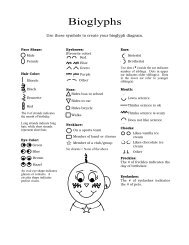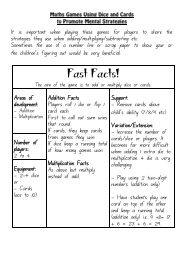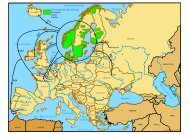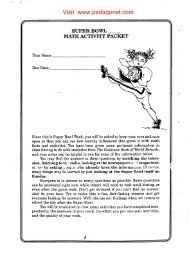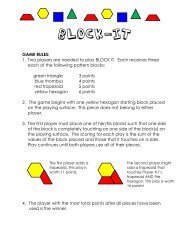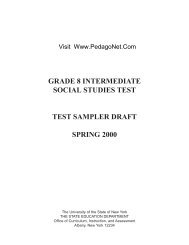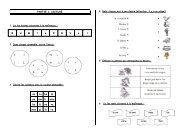Eratosthenes' Sieve - PedagoNet
Eratosthenes' Sieve - PedagoNet
Eratosthenes' Sieve - PedagoNet
You also want an ePaper? Increase the reach of your titles
YUMPU automatically turns print PDFs into web optimized ePapers that Google loves.
Leader Overview<br />
Many middle schoolers struggle with the<br />
multiplication table and problems that require this<br />
basic knowledge. This activity will help those who have<br />
difficulty with multiplication.<br />
This activity also introduces prime numbers. A prime<br />
number is a number that can be divided evenly only by 1<br />
and itself. “Divided evenly” means that the result is a whole<br />
number, with no remainder. Prime numbers and their<br />
properties were first studied extensively by ancient Greek<br />
mathematicians, including Eratosthenes (pronounced<br />
AIR-a-TOSS-the-knees).<br />
Preparation and Materials<br />
Each member of your group will need:<br />
• a pencil<br />
• 4 different-colored pens or markers (yellow, red, green,<br />
and blue)<br />
• a copy of Hundreds Chart<br />
This activity works best if you lead your group through the<br />
steps, using Eratosthenes’ <strong>Sieve</strong> as your guide. If you want people<br />
to work independently, each will need a copy of Eratosthenes’<br />
<strong>Sieve</strong>.<br />
Using This Activity<br />
By completing Eratosthenes’ <strong>Sieve</strong>, people will acquire a tool<br />
to help them play Hopping Hundred (page 55) and Tic-Tac-<br />
Toe Times (page 61), games that require knowledge of the<br />
multiplication table. You may want to do this activity right<br />
before playing one or both of those games.<br />
Tips for how to use Eratosthenes’ <strong>Sieve</strong> start on page 53.<br />
ACTIVITY<br />
Eratosthenes’ <strong>Sieve</strong><br />
Planning chart<br />
Finding the prime<br />
numbers by using<br />
Eratosthenes’ <strong>Sieve</strong><br />
46 Activity 6 • Eratosthenes’ <strong>Sieve</strong> The Math Explorer<br />
Published by Key Curriculum Press / © 2003 Exploratorium<br />
6<br />
20 minutes
Eratosthenes’ <strong>Sieve</strong><br />
If you’ve ever made cookies, you may have used<br />
a sieve to sift flour. A sieve is a device with a<br />
bottom that’s full of tiny holes. It lets fine flour<br />
particles through but retains the lumpy bits.<br />
Eratosthenes (pronounced AIR-a-TOSS-theknees)<br />
was an ancient Greek athlete,<br />
astronomer, and mathematician. His sieve<br />
doesn’t sort out lumps of flour. It sorts out<br />
prime numbers. A prime number is a<br />
number that can be divided evenly only<br />
by 1 and itself. “Divided evenly” means<br />
that the result is a whole number, with no<br />
remainder.<br />
What Do I Need?<br />
p a pencil<br />
p a Hundreds Chart (page 52)<br />
p 4 different-colored pens or markers (yellow, red, green,<br />
and blue)<br />
What Do I Do?<br />
When you mark your Hundreds Chart according to the<br />
steps that follow, you’ll reveal all the prime numbers in<br />
the chart. At the same time, you’ll discover patterns that<br />
will help you remember the multiplication table.<br />
Step 1 Using your pencil, draw an X through the number<br />
1 on your Hundreds Chart. The number 1 is a special<br />
number. It’s not prime, because a prime number has to be<br />
evenly divisible by two numbers: 1 and itself. The number<br />
The Math Explorer<br />
Published by Key Curriculum Press / © 2003 Exploratorium<br />
Activity 6 • Eratosthenes’ <strong>Sieve</strong> 47
1 is divisible by only one number: 1. So, it’s not prime.<br />
(That may seem picky, but mathematicians are like that<br />
sometimes.)<br />
Step 2 Look at the number 2. The number 2 is prime<br />
because only two numbers can divide into it evenly:<br />
1 and 2. Circle the 2 with your pencil.<br />
Step 3 Using your yellow marker, draw a vertical line<br />
through the center of the box the number 2 is in.<br />
Step 4 Find all the other multiples of 2 in the chart, and<br />
draw the same yellow vertical line through each of them.<br />
Is 3 a multiple of 2? How about 4? The number 4 is a<br />
multiple of 2 because it equals 2 2.<br />
To find the multiples of 2, look for the even numbers.<br />
Be sure to draw a yellow vertical line through every even<br />
number between 2 and 100. Do you see a pattern in the<br />
multiples of 2?<br />
Step 5 At the bottom of your chart, you’ll find a place to<br />
create a key to help you remember what the different<br />
colors indicate. Draw a yellow vertical line through the<br />
box labeled “Multiples of 2.” Any number that has a<br />
yellow vertical line through it is a multiple of 2.<br />
Step 6 Look at the next number in the top row: 3. Is 3 a<br />
prime number? It is, because it can be divided evenly only<br />
by 1 and 3. Circle the 3 with your pencil.<br />
Step 7 Using your red marker, draw a diagonal line across<br />
the box containing the number 3. Make the diagonal from<br />
the bottom left corner to the top right corner.<br />
Eratosthenes’ <strong>Sieve</strong> (page 2)<br />
48 Activity 6 • Eratosthenes’ <strong>Sieve</strong> The Math Explorer<br />
Published by Key Curriculum Press / © 2003 Exploratorium
Step 8 Using the red marker,<br />
draw the same diagonal<br />
through all the multiples of 3<br />
in the chart. The number 6 is a<br />
multiple of 3; it is 3 multiplied<br />
by 2. Find all the multiples of 3<br />
between 3 and 100. After you’ve<br />
marked several multiples of 3, you<br />
may be able to find a pattern to<br />
help you locate the others.<br />
There is also a trick for<br />
finding the multiples of 3. Add<br />
up the digits, and if that sum<br />
is a multiple of 3, then the<br />
number itself is a multiple of 3.<br />
Step 9 In the key at the bottom of<br />
your chart, draw a red diagonal line through the box<br />
labeled “Multiples of 3.”<br />
Notice that some boxes in your chart have both a<br />
yellow vertical line and a red diagonal line. These numbers<br />
are multiples of both 2 and 3. If a number is a multiple of<br />
two numbers, it’s also a multiple of those two numbers<br />
multiplied together! So, these boxes show you the<br />
multiples of 2 3, or 6. Mark this on your key, too, by<br />
drawing both a yellow vertical line and a red diagonal line<br />
in the box labeled “Multiples of 6.”<br />
The Math Explorer<br />
Published by Key Curriculum Press / © 2003 Exploratorium<br />
Eratosthenes’ <strong>Sieve</strong> (page 3)<br />
Activity 6 • Eratosthenes’ <strong>Sieve</strong> 49
Step 10 Continuing along the top row of the chart,<br />
notice that 4 is already marked with a yellow vertical line,<br />
reminding you that it’s a multiple of 2, so it can’t be a<br />
prime number. The next number, 5, is prime, so circle it<br />
with your pencil.<br />
Using your green marker, draw a vertical line through<br />
the 5. Draw this green line a little left of center so that<br />
you don’t cover up any of the yellow lines you already<br />
drew in the multiples of 2.<br />
Step 11 Find all the multiples of 5 in the chart, and draw<br />
the same green line through each of them. The trick to<br />
finding multiples of 5 is to look for numbers that end in 5<br />
or zero. Look for a pattern that will help you find all the<br />
multiples of 5. In your key, draw a green line through the<br />
box labeled “Multiples of 5.”<br />
Step 12 Looking at your key and your chart, can you<br />
figure out what set of colored lines shows you the<br />
multiples of 10? (Here’s a hint: 2 5 10.) Now look for<br />
multiples of 15 (which is 3 5) and 30 (which is 3 5 2).<br />
Add these to your key.<br />
Step 13 The number 6 has already been marked. The<br />
number 7 is the next prime. Circle 7 with your pencil.<br />
Using your blue marker, draw a diagonal line across 7. This<br />
time, draw the diagonal from the top left corner to the<br />
bottom right corner so that it doesn’t cover up the<br />
diagonal you drew for multiples of 3.<br />
Step 14 Find all the multiples of 7 in the chart, and draw<br />
a blue diagonal line through each of them. There is no<br />
trick for finding multiples of 7, but these numbers do form<br />
a pattern on your chart. Look for the pattern.<br />
Eratosthenes’ <strong>Sieve</strong> (page 4)<br />
50 Activity 6 • Eratosthenes’ <strong>Sieve</strong> The Math Explorer<br />
Published by Key Curriculum Press / © 2003 Exploratorium
Step 15 In your key, draw a diagonal blue line through<br />
the box labeled “Multiples of 7.” If you want to, you can<br />
add other boxes to your key. Can you figure out what set<br />
of colored lines shows you multiples of 14? Or 21? Or 35?<br />
Step 16 Continuing along the chart, notice that 8, 9, and<br />
10 are already marked. There are no prime numbers left in<br />
the top row. All the numbers that haven’t been marked<br />
yet are the remaining primes between 1 and 100. Circle all<br />
the remaining numbers.<br />
Step 17 How many prime numbers are there between<br />
1 and 100? You should get the same answer as everyone<br />
else in your group.<br />
The Math Explorer<br />
Published by Key Curriculum Press / © 2003 Exploratorium<br />
Eratosthenes’ <strong>Sieve</strong> (page 5)<br />
Activity 6 • Eratosthenes’ <strong>Sieve</strong> 51
Explorer’s Name: Date:<br />
Hundreds Chart<br />
1 2 3 4 5 6 7 8 9 10<br />
52 Activity 6 • Eratosthenes’ <strong>Sieve</strong> The Math Explorer<br />
Published by Key Curriculum Press / © 2003 Exploratorium
Tips for Leaders<br />
Leading Your Group<br />
Through Eratosthenes’<br />
<strong>Sieve</strong><br />
By taking a different approach, this activity<br />
may help people who have never managed to<br />
memorize the multiplication table. Mastery of<br />
the multiplication table is important for<br />
middle schoolers because this knowledge is<br />
essential to working effectively with fractions<br />
and doing algebra.<br />
About Eratosthenes<br />
Eratosthenes, the Greek mathematician who<br />
developed this method of finding prime<br />
numbers, was born in 276 B.C. in Cyrene,<br />
which is now in Libya in North Africa. He is<br />
the first person known to have calculated<br />
Earth’s circumference.<br />
Getting Ready<br />
This activity is easiest to lead if everyone has<br />
pens or markers in the same four colors. The<br />
instructions assume that everyone has yellow,<br />
red, green, and blue, but you can adjust if you<br />
need to.<br />
Before your group starts, make sure the<br />
members know the difference between odd<br />
numbers and even numbers. You should also<br />
discuss multiples. A multiple is what results<br />
when you multiply a number by other<br />
numbers. Some multiples of the number 2,<br />
for instance, are 4 (which is 2 2), 6 (which<br />
is 2 3), and 14 (which is 2 7).<br />
The best way to present this activity is to<br />
demonstrate each step and have people follow<br />
along, step by step. We suggest that you<br />
provide a copy of Hundreds Chart (page 52) to<br />
The Math Explorer<br />
Published by Key Curriculum Press / © 2003 Exploratorium<br />
each member of your group and lead the<br />
group through the activity using the<br />
Eratosthenes’ <strong>Sieve</strong> instructions (page 47) as<br />
your guide. If you want people to work<br />
individually, you can give each a copy of the<br />
Eratosthenes’ <strong>Sieve</strong> instructions as well.<br />
Finding Patterns<br />
Here are some of the patterns that group<br />
members may notice as they work through<br />
the activity:<br />
• All multiples of 2 are even numbers.<br />
• All multiples of 2 are lined up in vertical<br />
columns on the chart.<br />
• Multiples of 3 form diagonals in the chart.<br />
• Multiples of 5 are lined up in vertical<br />
columns under the numbers 5 and 10.<br />
• Multiples of 7 form a pattern that<br />
resembles the way the knight moves in<br />
chess. Start with a multiple of 7, and move<br />
two rows down and one column to the<br />
right. There you’ll find another multiple<br />
of 7.<br />
Tricks to Remember<br />
While marking their charts, people can learn<br />
a few tricks that will help them with<br />
multiplication:<br />
• The trick to finding multiples of 2 is to<br />
look for even numbers.<br />
• The trick to finding multiples of 3 is to<br />
add up the digits. If the sum is a multiple<br />
Activity 6 • Eratosthenes’ <strong>Sieve</strong> 53
Tips for Leaders<br />
of 3, then the original number is a<br />
multiple of 3, too.<br />
• The trick to finding multiples of 5 is to<br />
look for numbers ending in 5 or zero.<br />
Marking the Key<br />
Make sure everyone updates the key at the<br />
bottom of the chart each time a new set of<br />
multiples is marked.<br />
The key gets more interesting when<br />
people start marking multiples of composite<br />
numbers. (Remember, a composite number is a<br />
number found by multiplying two or more<br />
numbers together.) Once a chart is marked<br />
with all the multiples of 2 and 3, it’s easy to<br />
find all the multiples of 6. Because 6 is equal<br />
Where’s the Math?<br />
Understanding prime and composite<br />
numbers helps people when they are<br />
working with fractions.<br />
When students are adding or<br />
subtracting fractions, they often have to<br />
find a common denominator—a multiple that<br />
two numbers have in common. Suppose<br />
your group had to add 2<br />
<br />
5 and 1<br />
6<br />
. One look at<br />
the completed charts reveals that 30 is the<br />
smallest number that is a multiple of 5 and<br />
of 2 and 3 (or 6). So, they would know that<br />
30 is a common denominator of 5 and 6.<br />
Another common fraction operation is<br />
writing a fraction in its lowest terms. That<br />
to 2 3, any box that’s marked as a multiple<br />
of 2 and a multiple of 3 is a multiple of 6.<br />
If a number is a multiple of two prime<br />
numbers, it’s also a multiple of those two<br />
numbers multiplied together!<br />
Counting the Prime Numbers<br />
After people have filled out the top row of the<br />
chart, all the remaining unmarked numbers<br />
are prime. Tell everyone to circle all the<br />
remaining numbers in pencil and count them.<br />
People may get different answers.<br />
Sometimes they miss a multiple. For example,<br />
it’s easy to overlook 91 as a multiple of 7. See<br />
if everyone can agree on the number of<br />
primes between 1 and 100. The correct<br />
number is 25.<br />
means finding the greatest number that<br />
will divide evenly into both the numerator<br />
(the top part of the fraction) and the<br />
denominator (the bottom part of the<br />
fraction). For example, if you asked group<br />
members to write 12<br />
30<br />
in lowest terms, they<br />
would need to find the greatest number<br />
that divides evenly into both 12 and 30.<br />
The completed chart shows that 12 and 30<br />
are both multiples of 6. Dividing 6 into<br />
both the numerator and the denominator<br />
2<br />
into 2 . By knowing which<br />
turns 1<br />
30<br />
54 Activity 6 • Eratosthenes’ <strong>Sieve</strong> The Math Explorer<br />
Published by Key Curriculum Press / © 2003 Exploratorium<br />
5<br />
numbers are prime, they would know that<br />
2<br />
and 1 cannot be reduced.<br />
2<br />
7<br />
23






